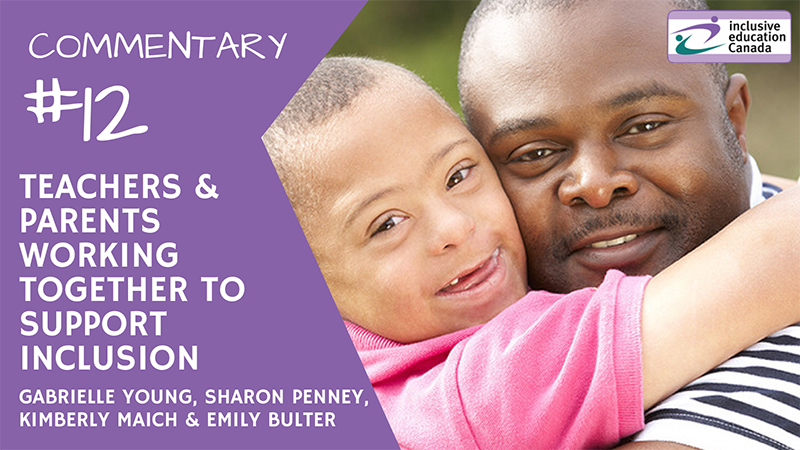 National Inclusive Education Month Commentary #12
National Inclusive Education Month Commentary #12
By Gabrielle Young, PhD; Sharon Penney, PhD, R. Psych; Kimberly Maich, PhD, OCT, BCBA; & Emily Bulter, Assistant Professor, Associate Professor, Master of Education Candidate, Faculty of Education, Memorial University of Newfoundland
Strategies to Promote Home and School Relationships Surrounding a Child with a Disability
Next to parents, teachers spend the most time with school-aged children (Hall, 2009). Teachers are responsible for the education and programming for children who are considered exceptional learners. The Salamanca Statement and Framework for Action on Special Needs Education (1994) launched UNESCO countries into the inclusive model of education; however, “Both parents and teachers may need support and encouragement in learning to work together as equal partners” (p. 38).
In the Canadian Context, every province and territory embraces the language of inclusive schools. This extends to the entire school culture and speaks to respect for diversity, the creation of learning communities that are welcoming and safe, and supports a sense of belonging. Each region has a model outlining the delivery of accommodations and supports to students with identified learning needs.
This paper presents findings from a study in Newfoundland, which explored the relationships between home and school when there was a child with a diagnosed disability. As researchers, we were interested in better understanding: What do families require to experience a positive working relationship with their child’s school when their child has a disability? We wanted to examine this topic because parents and teachers need support and encouragement in learning to work together, and obtaining parental perspectives may help us to understand their struggles, hopes, and dreams for their children with disabilities. We felt that by exploring parental perspectives we could: potentially create better relationships and collaboration through understanding, and potentially decrease the possibility of adversarial relationships.
What does the research literature suggest?
In regards to home-school communication, research highlights that communication has a “weighty influence” on a positive relationship with a school. Communication needs to be frequent and open, but also be honest. Previous research suggests that acknowledging a child’s accomplishments (the mode is not important), serves to strengthen parent-teacher communication (Fish, 2006). Recommended strategies to promote home-school collaboration focus on the importance of having frequent but honest communication and using daily report cards or school-to-home notes (Cox, 2005), and increasing positive communication between parents and teachers (Kelley & McCain, 1995).
When communicating information pertaining to assessment data or behavior, sensitive and straightforward language should be used. Educators should, “Use simple language; explain; define; and provide examples and anecdotes to help parents understand” (Martin & Hagan-Burke, 2002, p. 63). Educators should also avoid professional jargon, explain key terminology, and check with families to make sure they understand the information provided (Salend, 2006).
Research on parental involvement in the Individual Education Plan (IEP) planning process indicates that parental feedback and participation in their child’s IEP provides better programs for students (Fish, 2006; Fish, 2008; Rock, 2000). Unfortunately, IEP meetings often focus on the child’s failure, leading parents to limit their involvement in the educational planning of their child (Fish, 2006). Out of frustration, despair, or ignorance, some Canadian parents may choose to relinquish their active decision-making responsibility in their child’s educational programming (Rock, 2000). Effective communication between IEP team members or educators involved in transition planning has been noted as a major contributor to student success (Fish, 2006). Communication and involvement of parents in IEP and transition planning is a process that teachers and parents should nourish daily (Hebel & Persitz, 2014).
Educators need to recognize that parents can be their greatest allies, as parents have skills and experience that promote the learning process for their children (Obeidat, Osamha, & Al-Hassan, 2009; Cox, 2005). While positive learning outcomes are more likely to occur when parents are engaged in their child’s learning (Harris & Goodall, 2008); parent involvement is often through school-sanctioned events rather than as equal partners (Barton, Drake, Perez, St. Louis, & George, 2004). Interventions used with children who have special needs should engage parents as collaborative partners (Blue-Banning et al., 2004), for including parental concerns and related information for transition planning has provided positive outcomes for the family and child (Childre & Chambers, 2005).
What have we learned from parents?
The focus study offers insights on effective home and school communication from the perspective of parents and is focused on children with special needs. The findings are based on a focus group with four parents, consisting of three mothers and one father, representing three families. Parents addressed the importance of early identification. It is important to communicate early suspicions of behaviour or learning difficulties, as early identification and remediation promotes success. Assessment data needs to be communicated sensitively. Parents described how overwhelming it feels when assessment data are presented through educational jargon. While parents appreciated thoroughness in assessment, they benefited from the explanation of the assessment and what can be done to support their child. An intellectual disability or a specific learning disorder does not determine that child’s potential for success. Interpersonal skills and strategies, such as self-determination and advocacy skills, are predictive factors of success after graduation.
Parents are experts on their own children. Unfortunately, for participants in this study, recommendations and programming interventions suggested by the parents were not always implemented at school. When such parental recommendations were not taken into consideration, it resulted in less success, and was “definitely a more difficult year” for their child. Parents need to serve as strong advocates for their child. Parents highlighted the importance of speaking to their child’s teacher early in the year and providing them with as much information as you can. Parents discussed the importance of promoting open lines of communication and recommended that parents be available for contact. It was also recommended that parents write a letter to their child’s teacher highlighting their child’s strengths and needs, hobbies, interests, and expectations for learning in the classroom.
In order to promote home school relationships surrounding a child with a disability, educators need to provide parents with positive feedback surrounding their child, and this feedback needs to be specific and genuine. In regards to parent-teacher interviews, educators need to allocate adequate time for communication. Parents primarily have contact with their child’s school around academic and behavioural concerns, and were less likely to receive good news about their child. Instead of being deficit-based, communication needs to be solutions-oriented, with an emphasis on the child’s current level of achievement, and strategies and supports that can be put in place. Findings from the current study are supported by previous research indicating that teachers should comment on student’s strengths and promote honest and open communication. In order to promote home-school communication and collaboration, “schools meet regularly and hold IEP-focused reciprocal learning sessions for their parent community as well as for school staff” (Cobb, 2014, p. 302).
Parents and teachers need support in developing strategies to support home-school communication and learning how to become meaningfully involved in the development of their child or student’s IEP. Educators need to identify and communicate concerns early and sensitivity is needed when communicating assessment data. Educators can benefit from parental knowledge of children and the strategies that work best for them, and should utilize this knowledge to inform their instruction. Educators and parents to need to work together, as interactions between home and school can foster positive attitudes and promote positive outcomes for a child with a diagnosed exceptionality.
References:
Barton, A. C., Drake, C., Perez, J. G., St. Louis, K., & George, M. (2004). Ecologies of parental engagement in urban education. Educational Researcher, 33(4), 3-12.
Blue-Banning, M., Summers, J. A., Frankland, H. C., Nelson, L., & Beegle, G. (2004). Dimensions of family and professional partnerships: Constructive guidelines for collaboration. Exceptional Children, 70(2), 167-184.
Cobb, C. (2014). The three legged stool of parental inclusion: The case of Hana. British Journal of Special Education, 41(3), 290-308.
Childre, A., & Chambers, C. R. (2005). Family perceptions of student centered planning and IEP meetings. Education and Training in Developmental Disabilities, 40(3), 217-233.
Cox, D. D. (2005). Evidence-based interventions using home-school collaboration. School Psychology Quarterly, 20(4), 473-497.
Fish, W. W. (2006). Perceptions of parents of students with autism towards the IEP meeting: A case study of one family support group chapter. Education, 127(1), 56-68.
Fish, W. W. (2008). The IEP meeting: Perceptions of parents of student who receive special education services. Preventing School Failure, 53(1), 8-14.
Hall, L. J. (Ed.) (2009). Autism spectrum disorders: From theory to practice. Upper Saddle River: Pearson.
Harris, A., & Goodall, J. (2008). Do parents know they matter? Engaging all parents in learning. Educational Research, 50(3), 277-289.
Hebel, O., & Persitz, S. (2014). Parental involvement in the individual educational program for Israeli students with disabilities. International Journal of Special Education, 29(3), 58-68.
Kelley, M., & McCain, A. (1995). Promoting academic performance in inattentive children: The relative efficacy of school-home notes with and without response cost. Behavior Modification, 19(3), 357-75.
Martin, E. J., & Hagan-Burke, S. (2002). Establishing a home-school connection: Strengthening the partnership between families and schools. Preventing School Failure, 46(2), 62-65.
Rock, M. (2000). Parents as equal partners: Balancing the scales in IEP development. Teaching Exceptional Children, 32(5), 30.
Salend, S. J. (2006). Explaining your inclusion program to families. Teaching Exceptional Children, 38(4), 6-11.
UNESCO (1994). The UNESCO Salamanca Statement and Framework for Action on Special Needs Education. Paris: UNESCO. Retrieved from: http://unesdoc.unesco.org/images/0009/000984/098427eo.pdf
Gabrielle Young, Sharon Penney and Kimberly Maich are faculty members and Emily Butler is a student at the Faculty of Education, Memorial University of Newfoundland; Gabrielle Young is a member of the IEC Network of Associates.




